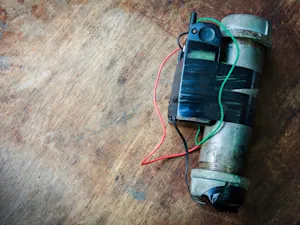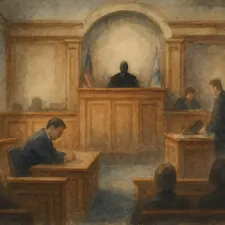
US Marshals Still Searching for Alcatraz Escapees
Alcatraz wasn't just a prison; it was the fortress of no return. Isolated by the frigid, unforgiving waters of San Francisco Bay, "The Rock" housed the country’s most dangerous criminals, including Al Capone and George "Machine Gun" Kelly. Its towering walls, iron bars, and relentless security made it a symbol of hopelessness. But in June 1962, three inmates rewrote its story with a breakout so ingenious that it still sparks debate today. This is the tale of the greatest escape Alcatraz has ever known.
Who were these men?
Frank Morris and brothers John and Clarence Anglin weren't just any criminals. Morris, orphaned as a child, had a rap sheet filled with burglaries, robberies, and escape attempts. His intelligence bordered on genius, a trait that earned him the leadership role in this infamous plan. The Anglin brothers, known for their charm and cleverness, had spent their lives pulling off bank heists. Together, the three shared an unyielding determination to outwit a system designed to crush hope.
Their bond grew tighter when they landed in adjacent cells at Alcatraz. Using whispers in the night, they crafted their plan. Allen West, another inmate with a knack for schemes, joined the plot but ultimately wouldn't make it out when the time came.
How did they plan an escape from 'The Rock'?
This escape wasn't a spur-of-the-moment stunt; it was a masterclass in ingenuity. Using spoons stolen from the dining hall, discarded saw blades, and even a vacuum cleaner motor turned into a drill, the men chiseled through the air vents in their cells. To hide their progress, they covered the holes with cardboard and other scraps. Every night, Morris played his accordion during music hour, masking the sound of drilling with melodies.
Behind the walls, the trio discovered a utility corridor, an unguarded space where they set up a clandestine workshop. Here, they turned 50 stolen raincoats into life vests and stitched together a rubber raft that was 6 feet by 14 feet. They melted the raincoats' seams using the prison's steam pipes and crafted paddles from plywood scraps.
Their creativity didn't stop there. They fashioned papier-mâché dummy heads using soap, toilet paper, paint, and real hair collected from the barbershop. These fake heads would buy them precious time during their escape by fooling guards into thinking they were asleep in their beds.
What happened on the night of the escape?
On June 11, 1962, the plan moved from theory to action. Morris and the Anglin brothers crawled through the holes in their cells, slipped into the utility corridor, and gathered their gear. Using plumbing pipes as makeshift ladders, they scaled a 30-foot wall, pried open a vent with a soap-based bolt, and climbed to the roof.
Under the cover of darkness, they descended a drainpipe, crossed the prison yard, and scaled two barbed-wire fences before reaching the island's northeastern shore.
Their final hurdle lay in the icy, treacherous waters of San Francisco Bay. Inflating their handmade raft using a converted concertina — a musical instrument similar to an accordion — the trio launched themselves into the waves. Behind them, Alcatraz loomed silent and unaware of their escape.
Allen West, the fourth member of the escape group, didn't make it. He couldn't remove the vent in his cell in time and was left behind to face the aftermath.
Did they survive?
By morning, the prison erupted in chaos. Guards discovered the dummy heads, and sirens wailed across the island. Authorities scoured the bay, finding a homemade paddle, a piece of the raft, and a life vest washed ashore. They uncovered a waterproof packet containing the Anglins' personal effects, but no sign of the escapees.
Despite the intense manhunt, no definitive evidence ever surfaced to confirm the trio's fate. The FBI concluded the men likely drowned, overwhelmed by the bay’s strong currents and frigid waters. Yet the absence of bodies left room for speculation. Inmates, experts, and amateur sleuths have argued for decades that the men could have survived.
In 2013, San Francisco police received a letter allegedly written by John Anglin. "I escape from Alcatraz in June 1962," the letter claimed, according to BBC. He added, "Yes, we all made it that night, but barely!" The author wrote that Morris had died in 2005 and Clarence in 2008. The FBI analyzed the letter but couldn't verify its authenticity.
Still Fascinating Today
The escape challenged everything people believed about Alcatraz. How could anyone outsmart what was supposed to be an impenetrable prison? The audacity of their plan — crafting tools and a raft from scraps, fooling guards with handmade dummy heads — captured imaginations worldwide.
Even today, the U.S. Marshals Service keeps the case open, occasionally releasing age-progressed images of the escapees. As recently as 2022, they appealed for tips, hoping to uncover the truth about Morris and the Anglin brothers.
Legacy of the Alcatraz Escape
The 1962 breakout remains one of the most daring prison escapes in history. It turned three inmates into legends and solidified Alcatraz's place in popular culture. From Clint Eastwood's portrayal of Morris in "Escape from Alcatraz" to ongoing documentaries and reenactments, the story continues to inspire.
While we may never know if they survived, their escape reminds us of the lengths people will go for freedom. Ingenious, audacious, and wrapped in mystery, the Alcatraz escape endures as a testament to human resilience and the allure of the unknown.
References: Alcatraz Escape | 'It was the cleverest escape in the prison's 30 years': The men who broke out of Alcatraz with a spoon























